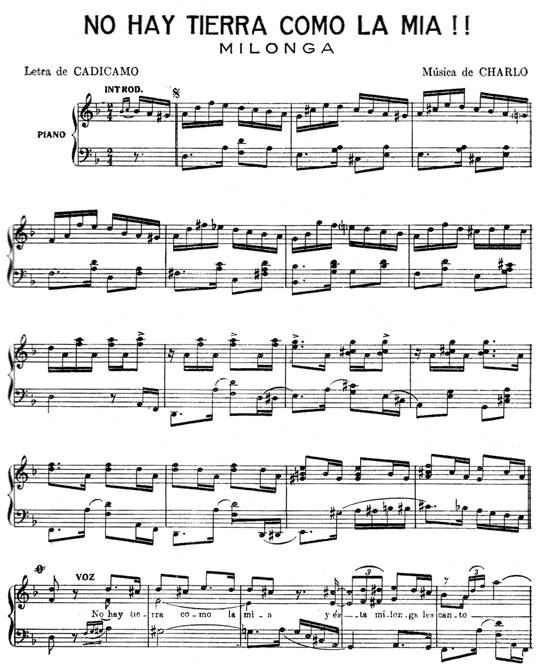A cheerful milonga
NO HAY TIERRA COMO LA MÍA
This milonga was written in 1939 by Charlo
(Carlos José Pérez) (music)
and Enrique Cadícamo (lyrics). We have three interpretations
from 1939: The
first was recorded by Francisco Lomuto on the 8th of August,
then Julio De Caro
on the 7th of September, and then Francisco Canaro on the 23th
of November.

The lyrics says "I love my homeland", and it's
sung in a very
enthusiastic way, in all versions. Even people who don't love
any homeland love
this milonga, because it's really driving and cheerful.
These are the versions we compare:
Francisco Canaro with Ernesto Famá
https://www.youtube.com/watch?v=X13qXxB1X40
Francisco Lomuto with Fernando Díaz
https://www.youtube.com/watch?v=yzAhHvvl6yQ
Julio de Caro with Héctor Farrel
https://www.youtube.com/watch?v=JN9AO2imKpg
Canaro's version is the most well-known. The
parts are short, and the
structure is ABABABA. The A part consists of two completely
different motives, the
first with a catchy melody in sixteenth, and the second
starting with a series
of off-beats of sixteenth, rhythmically challenging! In the B
part we have a
lot of dotted notes and small rubatos, which produces a very
cool elasticity.
The second B part is sung by Ernesto Famá with his metallic,
almost breaking
voice that expresses well the enthusiastic lyrics, in dialogue
with the
bandoneons. After the singing we have a piano solo and later a
trumpet solo.
Lomuto's version is quicker and even more
energetic. In the first parts,
the arrangement is more or less the same as in the Canaro
version, without the
nice rubatos in the B part. But then the singer comes back and
sings two more
verses, and after the singing,
the key
changes and the energy gets to a culmination point.
And in De Caro's version we have complete
craziness: bandoneons with
extreme rubato and dissonances and "chaotic" interplay with
the
violins, and then the singer with even more extreme rubato.
And after the
singing the last A part with a new countermelody and the
abrupt end. This is
with 1:56 the shortest version (and one of the shortest
milongas ever).